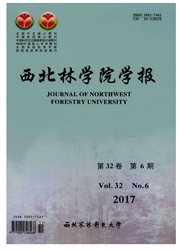

 中文摘要:
中文摘要:
用固定标准地结合临时样地的方法对延安研究区退耕初期不同退耕年份植被恢复过程中群落形成、组成及其变化进行了研究。结果表明:①沙蓬和黄花蒿首先占据退耕地,甚至可形成单优群落。②退耕3 a后,土壤结皮逐渐发育,限制了沙蓬种子的萌发,其他物种趁机占领沙蓬的生态位,群落组成相对丰富,主要植物种有黄花蒿、狗尾草、铁杆蒿、达乌里胡枝子及杠柳。③若群落内或周围有杠柳“母树”,第4~5 a就可以形成杠柳群落;样地周围若有白刺花种源,同期内白刺花也可进入样地,但不会成为优势种。④退耕地植物群落形成和演替的前期,演替进程主要是由该立地初期所拥有的植物种类决定。⑤植物群落动态变化及演替过程中,种间替代是逐渐的,演替系列是连续的,而不是离散的。
 英文摘要:
英文摘要:
The composition and development of plant community in the process of natural vegetation restoration on the rehabilitated land in early years were studied by means of fixed and temporary sample plots in Yanlan experimental area. The results indicate that (1) Squarrose agriophyUurn (Agriophyllurn arenariurn)and sweet wormwood (Arternisia annua)were two main kinds of pioneer plants even to form dominated community. (2)After the third year, with the development of biological soil crust,the plant community species were abundant, such as Setaria viridis, Artemisia scoparia, Poa sphondylodes, Stipa bungeana ,Tripolium vulgare,Heteropappus altaicus,Lespedeza daurica. (3)Near the pots, if there existed seed shrubs of Periploca sepiumsepium or Sophara viciifolia ,they could form communities in the plots after third year. Periploca sepiumsepiurn, a widely distributed species, could also develop nondominated community at 4^th to 5^th years. (4)The early succession process usually depended on plant species that existed in the early plant community. (5) In succession process, the plant community could not be regarded as a "organism'; their successional series were continuous, not discrete.
 同期刊论文项目
同期刊论文项目
 同项目期刊论文
同项目期刊论文
 期刊信息
期刊信息
